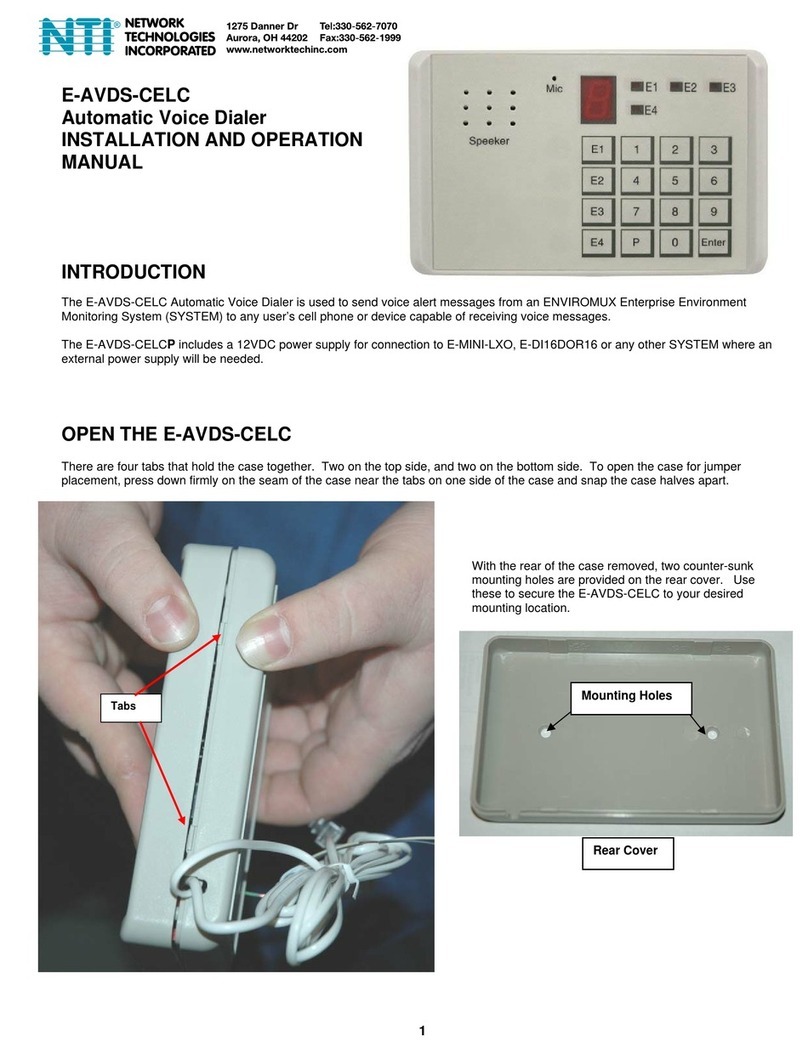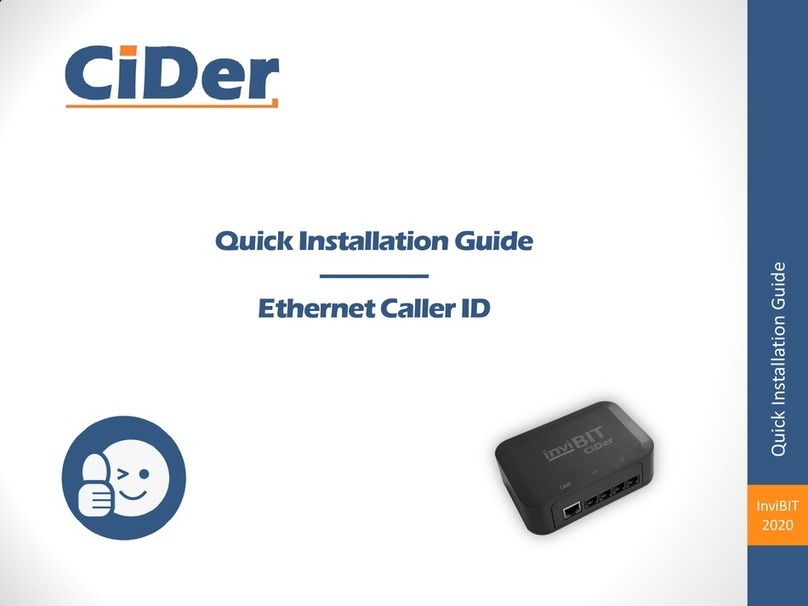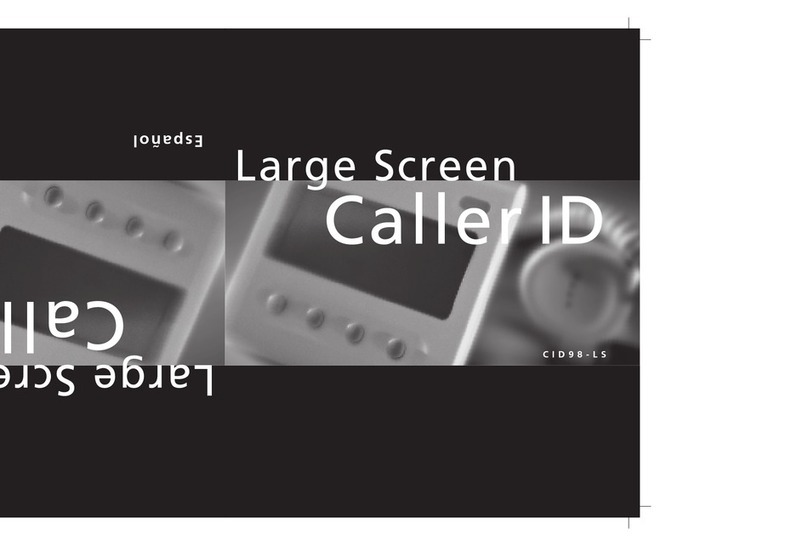NTI E-AVDS-4G1 User manual

1
E-AVDS-4G1/3/4
4G Automatic Voice Dialer
INSTALLATION AND OPERATION
MANUAL
INTRODUCTION
The E-AVDS-4Gx (x- 1,2 or 3) 4G Automatic Voice and SMS Dialer is used to send voice alert or SMS messages from
an ENVIROMUX Enterprise Environment Monitoring System to any user’s cell phone or device capable of receiving voice
or SMS messages.
The E-AVDS-4Gx-Pincludes a 12VDC power supply for connection to E-MINI-LXO, E-DI16DOR16 or any other
Enterprise Environment Monitoring System where an external power supply will be needed.
Features
Ideal for remote places without conventional phone lines.
Calls or sends SMS to up to 8 telephone or cell phone numbers when a sensor goes out of range of a
configurable threshold.
oMini SIM card supporting SMS messaging required (not included).
Stores one outgoing voice message of up to 20 seconds and sends one SMS message of up to 70 bytes.
E-AVDS-4G1
o4G LTE network band: FDD B2/4/12
o3G network band: WCDMA B2/5
E-AVDS-4G3
o4G LTE network band: FDD B1/3/5/7/8/20, TDD B38/40/41
o3G network band: WCDMA B1/5/8
o2G network band: GSM 900/1800MHz
E-AVDS-4G4
o4G LTE network band: FDD B1/2/3/4/5/7/8/28, TDD B40
o3G network band: WCDMA B1/2/5/8
o2G network band: GSM 850/900/1800/1900MHz
Interfaces with the E-2D/5D/16D via the Output Relay connections.
Powered by the E-2D/5D/16D.
Maximum current: 350mA @ 12VDC
Dimensions WxDxH: 5.87x3.54x1.25 in (149x90x32 mm)
oIncluded Antenna dimensions WxDxH: 1.18x1.18x3.9 in (30x30x99 mm)
Operating temperature: 39 to 140°F (4 to 60°C)
For normally closed or normally open circuit connections.

2
Materials included with this kit:
E-AVDS-4Gx Voice dialer
4G Antenna
URL slip with path to this manual
Included with E-AVDS-4Gx-P Only:
100-240VAC @ 50\60Hz; 12VDC 1A AC Adapter ("-P" model only)
Country-specific Line Cord
2 ea. WC-UR2 (CN1469) butt splice connectors
OPEN THE E-AVDS-4Gx
To configure the E-AVDS-4Gx(-P) for operation and to access the mounting holes, you must first open the case of the
dialer.
There are four tabs that hold the case together. Two on the top side, and two on the bottom side. To open the case for
jumper placement, press down firmly on the seam of the case near the tabs on one side of the case and snap the case
halves apart.
Tabs
With the rear of the case removed, two counter-
sunk mounting holes are provided on the rear
cover. Use these to secure the E-AVDS-4Gx to
your desired mounting location.
Mounting Holes
Rear Cover

3
CONFIGURE THE JUMPERS
Configure the jumpers on the E-AVDS-4Gx to be triggered by either the Normally-Closed (N.C.)or Normally-Open (N.O.)
relay contact on the E-xD. In the image below, the jumpers are set for connection to the N.O. terminal.
To set the “normal” relay state to Normally-Open, apply the J1 jumper to the center and right pin, and J2 jumper to the
center and left pin. In this configuration, a relay closure will trigger an alert state, activating the dialer.
To set the “normal” relay state to Normally-Closed, apply the J1 and J2 jumpers to the center and left pins. In this
configuration, a relay open condition will trigger an alert state, activating the dialer.
CAUTION: TO PRESS THE RESET BUTTON, INSERT A NON-CONDUCTIVE MATERIAL BETWEEN THE
CIRCUIT BOARDS WHILE THE UNIT IS ON AND PRESS THE BUTTON. USING A CONDUCTIVE
MATERIAL MAY SHORT THE CIRCUIT BOARD AND DAMAGE YOUR DIALER, VOIDING THE
WARRANTY.
NOTE: The “VOLTAGE” jumper position is not used in conjunction with the E-xD.
With the jumpers properly set, and the rear panel securely mounted, re-assemble the case.
J1 J2
RESET
BUTTON
PRESS RESET BUTTON
TO RESET PASSWORD TO
“0911”
J1 J2

4
WIRING METHODS
Connect the cable from the E-AVDS-4Gx to the E-xD according to one of the following diagrams:
Note: The attached cable is 700mm (27 inches) long but can be extended up to 100 feet with any 3-conductor
22AWG (minimum) cable.

5

6
FEATURES
(1) Speaker
(2) Microphone
(3) LED 7-segment display- displays the signal strength, number input, and provides indicators for phone numbers
When the dot of display blinks slowly, it means the FULL NETCOM module is working normally;
When the dot of display blinks fast, it means the FULL NETCOM module is faulty.
(4) “E1” – “E8” indicators: ON while setting E1-E8 phone/mobile phone numbers.
Note: E1 through E8 indicators will illuminate while setting the password.
(5): FULL NETCOM indicator:
LED indicator OFF = FULL NETCOM module is powered OFF or not working.
200ms ON and 200ms OFF = data communication built.
800ms ON and 800ms OFF = network register successful.
LED indicator ON: sending alarm or data communication transmitting.
(6) Connection Cable
red (or orange) = 12V
black (or brown) = Negative (ground)
yellow = Digital Contact
(7) Buttons: used to enter programming
GENERAL INFORMATION
Recording Duration: 20 seconds,
Telephone numbers and voice message programming remain intact even if the power is OFF.
SMS Message: Up to 70 characters can be programmed.
Telephone Number Storage: 8 telephone numbers and each can be a maximum of 16 digits.
Private Password: 4-digit Private Password
Default Password: 0911

7
AUTO-DIALER OPERATION
Power ON Self-Test:
The Dialer will perform a self-test checking signal connection when powered ON. After the self-test, if a connection is
made the number on the display will indicate the signal strength (1 = weak, 5 = strong), the decimal point at the lower
right corner on the 7 segment display will blink slowly and the dialer will be ready to work.
Note: If no signal is found, the decimal point will blink rapidly and "0" will be displayed.
If configuration (phone numbers and voice message) already exists, the AUTO-DIALER will alarm automatically upon
receiving an alarm signal. To setup or change the configuration, please follow the procedures below to save and check
telephone numbers and passwords as well as to record and play back recorded voice message:
1. Log into the Programming Mode:
First press PAUSE , then put in the Private Password (4 digits), then press ENTER
Note: The Default Password is 0911
For instance: Log into the Programming Mode as follows:
PAUSE 0911 ENTER
If the password you entered in is correct, the LED will display "5", and then log into the Programming Mode,
If the password you entered is incorrect, the LED will display “E” and return to the working mode. Repeat the
procedure to try again.
2. Program and Check SMS Center Number
If you do not program the SMS Center number (your carrier's connection number) after powering ON the dialer, it will
automatically obtain the number by default.
We recommend to allow the dialer to automatically obtain SMS center number in normal use.
To view the current SMS Center number: Under programming state (in“5”state): press “3”and “0”; the dialer will display
the SMS Center number, and user will hear a tone “Du”. If the number is not correct, perform the following to change it:
Under programming state ( "5" on the display): press “0”and then input SMS center number, and press “ENTER”. (You
will need to get this number from your carrier if the dialer does not obtain the number automatically)
For example: 0+18965713028=ENTER.
The dialer will display “∩”if it receives a correct input.
To delete the SMS center number: under programming state, press “0”and then“ENTER”. The dialer will display "∩”if it
receives a correct input.

8
3. Program the Telephone numbers and Alarm methods for each
This dialer supports two alarm methods: voice alarm and SMS alarm
Under programming state, press E1, E2, E3...E8 to save alarm receiving numbers and alarm methods.
Example : number is 18965713028, choose voice alarm. Operation: E1→18965713028→ENTER→1→ENTER.
The dialer saves the number when the 1st “ENTER”is pressed.
Next enter the "1" for the alarm method, this chooses voice alarm. (For SMS alarm method, substitute a "2")
Next press “ENTER”to save the alarm method.
If "∩" and then “0” is displayed it means the input was correct and the dialer returns to a programming state “5”. User
can perform the operation again in state “5”.
To delete the 1st group number : Press E1→ENTER.
4. Check the telephone numbers and corresponding alarm method
Under programming state, press “3”and then E1-E8 . The numbers and corresponding alarm method will be displayed.
Operation: “3”→E1/E2/E3/E4→display
Displayed: the alarm method(1 or 2)→A→phone number, then hear a “Du”voice after display.
5. Save and playback the audio message
1. This dialer supports a 20 second voice message. (A shorter message will have the best quality).
Under programming state (“5”displayed), press “1”( “『”displayed means begin recording), and then begin talking and
recording →after which you will hear "Du" (The dialer will stop automatically and playback the voice message after it
has finished recording).
The User can stop recording a message by pressing “ENTER”during recording.
2. Playback the recorded message:
Under programming state, press “3, 1”( a “p”displayed means play), recorded message playback begins, and is ended
with a “Du”after finishing.
6. Save short text message (maximum 70 bytes/letters can be entered)
Under the programming state, press “2”then send an SMS message from a phone to the SIM card's phone number (no
more than 70 bytes/letters (phone number will be provided by the SIM card provider). If more than 70 bytes, it will only
identify the front 70 bytes.).
If “∩”displays after the message has been sent and a "Du" is heard, it means the message has been input and will return
to state “5”;
If “E”displays, it means timeout. You need to try again following the above steps after returning to state “5”.
(Note: Keyboard is not operable when waiting for message reply. You will need to wait 2 minutes if the message
times out. If you send a message to the dialer the first time and dialer fails to receive it may because of a
network fault. The User can send it again or start up the dialer again, allow the machine to search network or Esc
by pressing “ENTER”. For example: “2”→ENTER. The Default message text is “DA-911LTE ALARM”)

9
7. Program and Check number of times to repeat dialing in an alarm state
With the dialer in a programming state: press “6”to input alarm dialing times (0-9), press "ENTER”.
If “∩”displays it means the input was correct, and the dialer will return to state “5”.
Program how many times dialing should be repeated during an alarm state (initial setting is 5 times)
0= unlimited dialing;
1-9: repeat dialing 1-9 times
To find out how times the dialer is programmed to repeated dialing:
While in a programming state, press “3”and then “6”,
the 7-segment display will show the number of times it is programmed to repeat dialing, and then you will hear a
“Du”.
Note: for SMS alarm methods, the dialer will stop sending the message if the message is sent successfully. It is
not ruled by the programmed number of repeat dialing times.
8. Save and Check password:
To store a password (Initial password is 0911): the dialer supports a 4-digit private password.
If the private password will be 1234, while operating in a programming state:
press “PAUSE”→“1”“2”“3”“4”→“ENTER”and hear a tone “Du”which means the input is finished
(the password must be 4 digits, if less than 4 digits, system will display “E”and enter state
“5”..
Inquire password; in programming state (state “5”), press “3”and then “PAUSE”, monitor display password, and hear a
tone “Du’after display is done.
Note: If user loses the password, they can open the back cover of the dialer, power the Dialer ON, and press the
“RESET BUTTON" (see page 2). Password will be changed to the default one: 0911, but all other programmed
information (data) will not be lost.
CAUTION: TO PRESS THE RESET BUTTON, INSERT A NON-CONDUCTIVE MATERIAL BETWEEN THE
CIRCUIT BOARDS WHILE THE UNIT IS ON AND PRESS THE BUTTON. USING A CONDUCTIVE
MATERIAL MAY SHORT THE CIRCUIT BOARD AND DAMAGE YOUR DIALER, VOIDING THE
WARRANTY.
9. Program and Check alarm trigger delay
You can control the delay time that the trigger must be present before the dialer will go into an alarm state and begin
dialing.
In programming state, press “7”and enter the triggering delay (0=0.5 second,1=1 second, 2=2 seconds,.....9=9
seconds), and then press “ENTER”.
If “∩”is displayed it means the input is correct and it will return to state 5.
To determine the presently programmed delay time:
In programming state, press “3”and “7”,
The 7-segment display will show triggering time , followed by a tone “Du”.
Note: the default trigger delay time is 0.5 second.
10. Stop Alarm Dialing on Dialer.
While triggered, the AUTO DIALER will automatically alarm by dialing the numbers saved. If a user wants to stop it, input
private code while “0”displayed. Suppose code is 1234, “1234”will be displayed instead of “0”after input. If the code is
correct, the alarm will be withdrawn followed by the “Du…”sound, and the dialer will return to standby mode.
The User must input the 4 digit password correctly. An incorrect password will fail to withdraw the alarm.

10
11. Reset to factory default settings
In programming state (in state “5”), press “8”, input “911”and then “ENTER”
If “∩”is displayed it means correct operation, and will return to state “5”.
Note: Most of the settings can be restored to factory default, except for voice record and triggering method (jumpers)
These need to be manually reset.
TROUBLESHOOTING
1. If the SIM card is not installed or antenna not connected or FULL NETCOM module faults, the auto dialer will not able
to finish initialization, the alarm will not be sent.
2. Press “ENTER”to return to working state after finishing an operation. If “ENTER”is not pressed and the LED displays
“5”(programming state), it will lead to alarm communication failure.
3. Do not use the SIM card with PIN code protection function. If SIM card attached with the function, insert the card in
other mobile phone to close the function
(for example: using Nokia mobile phone, choose: Menu→setting→security setting→PIN protection→off).
4. If not sure about SMS center number, user can contact their local SIM card service center.
5. When setting the alarm mode to SMS alarm, be sure to enter the local country code in front of the phone number.

11
SPECIFICATIONS
Voltage DC 11V to 15V
Static current 60mA (Based on operating voltage: DC 12V)
Operating current 350mA (MAX) (Based on operating voltage: DC 12V)
Power Source Powered by the E-2D/5D/16D unless "-P" model;
"-P" model includes 12VDC 1A AC Adapter
Triggering mode N.C or N.O
Voice recording 20 seconds maximum; phone numbers and voice message will be
saved after power off
Phone numbers Up to 8 , 16 digits maximum
Private password protection 4-digit private password programmable
Default password = 0911
SMS Support system supports SMS message alarm (70 characters maximum)
Operating Temperature 39 to 140°F (4 to 60°C)
Dimensions (WxDxH) 5.87x3.54x1.25 in (149x90x32 mm)
Included Antenna
dimensions (WxDxH) 1.18x1.18x3.9 in (30x30x99 mm)
Part # Supported Country Supported Bands* Supported Frequencies (in MHz)
FDD-LTE: B2/B4/B12 1900/1700/700E-AVDS-4G1 North America (AT&T)
WCDMA: B2/B5 1900/850
FDD-LTE: B1/3/5/7/8/20 2100/1800/850/2600/900/800
TDD-LTE: B38/40/41 2600/2300/2500
WCDMA: B1/5/8 2100/850/900
E-AVDS-4G3 Europe / Middle East /
Africa / South Korea /
Thailand
GSM 900/1800
FDD-LTE: B1/3/4/5/7/8/28 2100/1800/1700/850/2600/900/700
TDD-LTE: B40 2300
WCDMA: B1/2/5/8 2100/1900/850/900
E-AVDS-4G4 New Zealand / Australia /
South America
GSM 850/900/1800/1900
*Check with your service provider to determine what band(s) must be supported by your dialer for your area to determine
what model is right for you.
MAN387 Rev 9/2/20
This manual suits for next models
3
Table of contents
Other NTI Caller ID Box manuals





